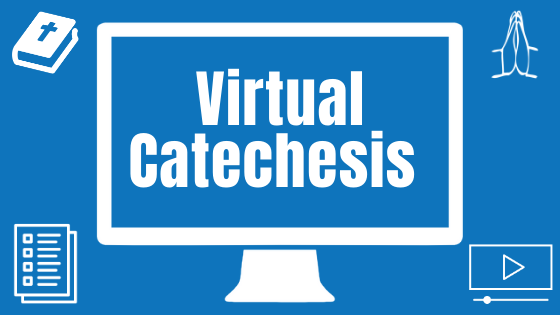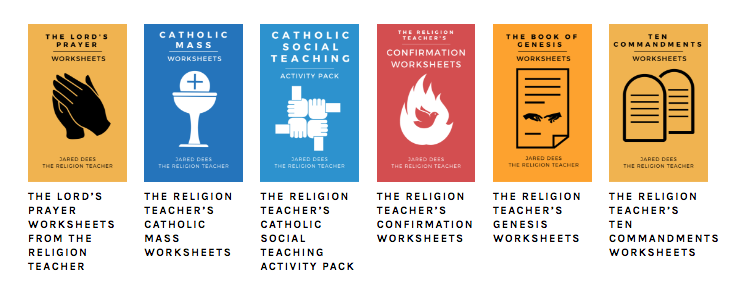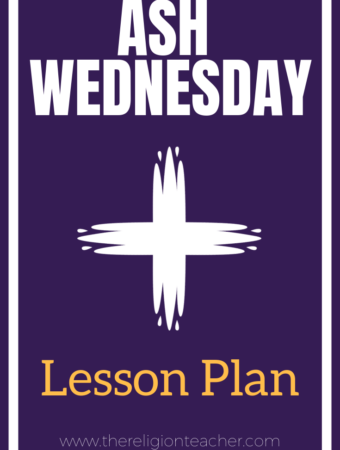
So, you are teaching virtually this year. Things are going to be different.
It certainly won’t be religious education as normal.
It might not be the year we expected.
But it could be an amazing year.
In response to the pandemic, many schools and parishes have chosen between:
- In-person classes with social distancing and masks
- Online Classes
- Homeschool
Digital learning in catechesis is a new experience for teachers, students, and parents.
Parishes and schools are focusing on so many different models. I won’t presume to know which model is best for every situation or every part of the world. I also won’t say which curriculum will work best in an at-home model (though I hope you will send families resources from The Religion Teacher to use at home).
No matter what model you design for your parish, keep in mind our primary priority:
Priority #1: Encounter Over Education
I can already imagine the complaints from naysayers about another generation of poorly catechized kids due to the impact of the coronavirus on religious education. I can already hear the fears that kids will fall short in learning Church teachings with virtual catechesis.
Let’s make something very, very clear about catechesis:
The purpose of catechesis is to cultivate an encounter with Christ NOT merely an education about doctrines.
Academic growth is not the same as catechetical growth or spiritual growth.
Our priorities in religious education will be different from every other form of online education.
Catechesis is not like math. It is not like science, history, literature, or any other subject students will be studying this year.
These three quotes from our most recent popes should inspire us to do catechesis differently than other forms of education:
“The definitive aim of catechesis is to put people not only in touch but in communion, in intimacy, with Jesus Christ.”
John Paul II
Catechesi Tradendae, 5
“Being Christian is not the result of an ethical choice or a lofty idea, but the encounter with an event, a person, which gives life a new horizon and a decisive direction.”
Pope Benedict XVI
Deus Caritas Est, 1
“On the lips of the catechist the first proclamation must ring out over and over: ‘Jesus Christ loves you; he gave his life to save you; and now he is living at your side every day to enlighten, strengthen, and free you.'”
Pope Francis
Evangelii Gaudium, 164
In the last few years, I have been sharing a vision for catechesis at The Religion Teacher as:
Every Day, Every Class, Every Student, an Encounter with Christ
I have been thinking about this a lot. “Class” has a new meaning with the rise of online learning. Now that so many of us are shifting towards new models for religious education outside of a classroom, I will be phrasing our vision a little differently:
Every Child, Every Day: an Encounter with Christ
Whether you are a catechetical leader, catechist, teacher, or school leader, this must be the vision we strive for this year.
At the end of the year, our families should look back on their association with parish catechesis and see the ways they have grown in their faith.
Will they look back with pride about the information their kids have learned?
Or will they find peace in the way the Catholic faith has led their children to know and love Jesus Christ. Will they be able to see their own spiritual growth?
Our relationship with Christ grows through constant, daily encounters that transform our lives in both little and profound ways.
Priority #2: Partnerships with Parents
If families and children invite us into their home for virtual catechesis, we have to think critically about giving them creative and simple ways to encounter Christ at home.
Catechesis must go beyond the curriculum to follow or a checklist of information to memorize and regurgitate in an online test.
Instead, we have to ask how we can help parents build into the daily lives of their children opportunities to encounter the Risen Lord. Every single day.
What an opportunity!!
This is one of the greatest opportunities for effective catechesis in our lifetimes!
A strong partnership with parents has always been ideal, but now it is absolutely essential.
No parent participation = No catechesis
We cannot hide in the sanctuary of our classrooms any longer.
Now, more than ever, the catechist fits the role of a companion and coach instead of a teacher.
Virtual Catechesis: The Three C’s of Success
Keep virtual catechesis consistent, connected, and on a calendar.
1) Keep catechesis consistent.
Families are already struggling with all aspects of at-home education. Keep the content of catechesis simple. Ask families to complete the same set of tasks week after week.
Just make sure that you get them beyond information to formation.
Make sure questions and activities you give to families help students make personal connections through meditation and prayer on what they learn.
If you have the freedom to manage your own content and curriculum, I suggest a simplified version of Lectio Divina Lesson Planning:
- Read
- Reflect
- Respond
Read: Read the textbook, Bible, article, etc. Watch a video. Listen to a podcast.
Reflect: All questions and activities should help students show comprehension, but also encourage them to meditate and pray about what they read or watched. The types of questions we ask are critical to effective religious education.
Respond: A child’s response should go beyond answers to quiz and test questions. Kids should pray about what they learned. They should think about ways they can live their lives differently after encountering God in catechesis.
2) Keep catechesis connected.
Make personal relationships a priority this year.
You & Parents
Communicate directly and personally with the families in your programs.
Email, call, text, and visit the homes of the families you serve (with social distancing of course).
You & Students & Students
If possible, foster communication with and between students.
You could schedule Zoom calls to bring your classes of students together. Use tools like FlipGrid or SeeSaw to enable the kids to communicate with each other.
3) Keep catechesis on a Catholic calendar.
It will be easy for families to become isolated from the Church this year at home.
Use the liturgical year to your advantage. Find unity around the weekly Gospel readings, saint feast days, and liturgical seasons (especially Advent, Christmas, Lent, and Easter).
Let the lectionary inspire your communication with families each week. The Scripture readings unite us all in a common experience of the Church.
How The Religion Teacher Can Help in Virtual Catechesis This Year

Ever since the pandemic began, I have received a lot of questions about the ability to use resources from The Religion Teacher for virtual catechesis.
Here is the best place to begin:
The Religion Teacher Sunday Newsletter
Every Sunday morning I send a weekly email newsletter with lesson ideas for the week ahead. This email includes links and lesson ideas that you can easily pass on and share with families at home. It will also continue to include ideas for the classroom.
I include the same kinds of resources you find here on the website each week: lesson plans, activities, worksheets, prayers, and videos.
Sign up here to get a free lesson planning eBook when you enter your email address.
FAQs about The Religion Teacher Resources
My mission is to create and collect practical tools (activities, lesson plans, prayers, worksheets, videos, etc.) to help religious educators lead their students to encounter Christ.
As you plan your virtual learning options, here’s how The Religion Teacher resources will help.
Emailing The Religion Teacher Resources to Parents
Many DREs and catechists send weekly emails with lesson ideas and activities for parents.
Please feel free to include links to The Religion Teacher website including individual articles in your emails and resource collections:
- Activities
- Class Videos (Find more on The Religion Teacher’s YouTube channel.)
- Lesson Plans
- Worksheets
- Class Prayers
eLearning and Virtual Classroom Resources
Many Catholic school religion teachers tell me that they are using Google Classroom and other learning management systems to communicate and conduct lessons online.
- Yes, you may share links to lessons and activities at The Religion Teacher.
- Yes, you may embed YouTube videos from The Religion Teacher.
- Yes, you may upload worksheets you have purchased from The Religion Teacher into these platforms as long as they are not freely available to the public.
- Yes, you may upload member resources into these platforms as long as they are not freely available to the public.
The Religion Teacher Membership Resources
Have you become a member of The Religion Teacher yet?
There are more than 700 downloadable resources including 100+ videos and 550+ worksheets available to members of The Religion Teacher including many of The Religion Teacher activity packs and worksheet packs.
Weekly Gospel Reading Worksheets

150+ Saint Worksheets

The Religion Teacher’s Activity and Worksheet Packs

How Members Use The Religion Teacher Member Resources for Virtual Learning
As a member of The Religion Teacher, you can download and share the member resources with your student and families.
Individual Memberships allow one religious educator (catechist or teacher) to share member resources with families in individual classes.
Group Memberships allow a DRE to share member resources with all catechists and their classes and all families within a parish or school.
An individual family can also purchase an individual membership for their children.
Instead of sharing the links to the video and worksheet pages with parents (which requires your login information to access):
Share Member Videos:
All member videos can be downloaded to your devices.
There are also special links for every member-only video that can be shared and viewed without logging in.
Don’t forget to send along the graphic organizers that go with each video. You may embed the member-only videos that are not on YouTube as long as they are not freely available to the public.
Share Member Worksheets:
Download the PDFs you want parents and students to use.
With a membership, you can email the files to families or upload them to your learning management system, Dropbox, Google Drive, etc.
Caution: Do not make these worksheets freely available to the public on parish or school websites.
A Virtual Catechesis Prayer
Here is Pope Benedict XVI’s prayer at the close of his first encyclical letter. I think it fits very well as a reminder of our priorities for the year:
Holy Mary, Mother of God,
you have given the world its true light,
Jesus, your Son – the Son of God.
You abandoned yourself completely
to God’s call
and thus became a wellspring
of the goodness which flows forth from him.Show us Jesus. Lead us to him.
Pope Benedict XVI
Teach us to know and love him,
so that we too can become
capable of true love
and be fountains of living water
in the midst of a thirsting world.
Deus Caritas Est, 42


